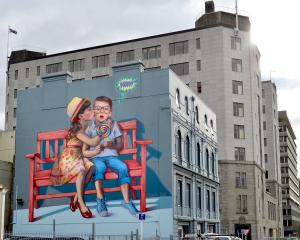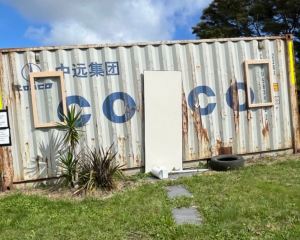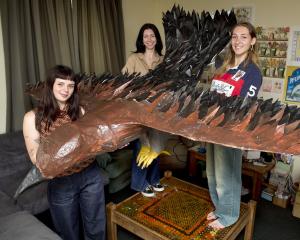Ships are part of man's endeavour - exploration, trade, war, aid, immigration, transport and tourism - and the memories of them have become part of those who have been on board. Kim Dungey takes a look at 'Ship Shape', the Hocken Gallery's new exhibition.
Ships might be inanimate objects but their histories read like biographies, say those behind a new exhibition at the Hocken Gallery.
"Ship Shape: Portraits of Ships from the Hocken Collections" draws on the wealth of shipping-related material that the library holds, from paintings and photographs to passenger diaries and lists of provision.
Exhibition curator Anna Petersen says the ships represented have been involved in many aspects of man's endeavour - exploration, trade, war, aid, immigration, transport and tourism - and memories of them have become part of those who have been on board.
Some of the material in the exhibition belonged to Captain Angus Cameron, who was the chief marine superintendent of the Union Steam Ship Company.
The Hocken holds 11 shelf metres of Cameron family papers, including correspondence, ship plans and photos.
Other images were taken from the thousands of negatives donated by Ian Farquhar, the former Otago Harbour Board chairman who was the founding president of the Friends of the Hocken Collections group.
The earliest work, dated 1767, is a hand-coloured engraving by Joseph Collyer (after Isaac Gilsemans).
It records the visit by two Dutch East India Company ships, the Heemskerch and Zeehann, under the command of Abel Tasman and Isaac Gilsemans, to Golden Bay in 1642.
Over the centuries artists developed certain conventions to capture the lines of their subjects, many adopting the Dutch style of marine painting, Dr Petersen says.
This developed alongside their art of map-making and spread ships out in profile against the sky on a body of water.
This approach was generally also taken by photographers, who sold portraits of ships to crew and passengers.
Among the Hocken collections are photos by David Alexander De Maus (1847-1925), who was based in Port Chalmers, and William Livermore, of Sydney, which are an internationally significant resource for anyone interested in 19th and early 20th-century shipping.
Some painters used artistic licence - sails are rigged in a picturesque if not strictly accurate way and flags perfectly unfurled in the wind, as seen in John Turnbull Thomson's 1851 painting of the clipper Poppy, which transported opium between India and China.
On a much smaller scale, there is a set of four paintings of ships on leaves, by Edmund O'Keefe, who exhibited at the Otago Art Society from 1876 to 1880.
Dr Petersen wanted to exhibit items from all over the Hocken Library so with the help of archivist David Murray and liaison librarian in charge of ephemera Katherine Milburn, she included photos of ship interiors, programmes for the concerts staged on board, menus offering creamed cabbage, green turtle and minced lamb brains, and even the design for a ship's mattresses.
Nineteenth-century diaries kept by immigrants on the long voyage to New Zealand offer another glimpse into life at sea.
The journey took about 100 days on the clipper route, depending on the weather, so arranging entertainment, producing newspapers and keeping diaries were ways to pass the time, Dr Murray said.
One such journal had feathers stuck into it.
"There are interesting little comments about other passengers and the fun that was had on one hand, while on the other hand there are very sad descriptions of deaths, often of children, and of burials at sea."
Various lists describe how much coal was burnt on steamers and what furnishings and stores had been bought.
Among the items listed are paintbrushes, nautical charts, gilt plates, pickle forks, blue moquette fabric for a first-class saloon and initial food supplies, which for the Union Steam Ship Company vessel Atua, included 600lbs of crew biscuits and 100 tins of herrings.
Founded in Dunedin, the Union Steam Ship Company was the biggest shipping company in the southern hemisphere and the country's largest private employer, plying coastal New Zealand and transtasman routes and trading to the Pacific Islands and North America.
The use of the word "portraits" in the exhibition's title refers to the fact that it brings together visual records of individual vessels and archival remains, from which character portraits can be developed, the pair say.
And the story of one of the Union Steam Ship Company vessels, Maheno, illustrates how each ship could be seen as having its own personality.
Entering service in 1905, Maheno had an elegant profile, along with comfortable and beautiful interiors. It was also very fast.
But the once-luxurious vessel had an eventful existence, evacuating soldiers from Gallipoli and later running aground on its way to shipbreakers in Japan before being used for bombing practice in World War 2.
The Hocken staff approached the exhibition from different perspectives. Dr Petersen initially knew little about shipping while Dr Murray had long been fascinated by its "industry meets nature" aspect.
Both wanted to show the range of material available to researchers.
Some institutions such as the Regional Maritime Museum at Port Chalmers have maritime history as their core business but many genealogists visit the Hocken for photos or drawings of the ships on which their ancestors arrived, Dr Petersen says.
"We live beside the sea. Ships are part of our heritage."
See it
"Ship Shape: Portraits of Ships from the Hocken Collections" opens tomorrow and continues until August 18.












